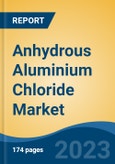Speak directly to the analyst to clarify any post sales queries you may have.
10% Free customizationThis report comes with 10% free customization, enabling you to add data that meets your specific business needs.
Available in powdered and granular forms, it is produced through the reaction of dry chlorine or hydrogen chloride gas with superheated aluminium or via heating alumina and coke with chlorine gas. Proper storage - sealed, dry, and away from combustible materials - is essential to maintain its reactivity and safety. The compound is also key in producing fumed alumina and titanium dioxide, and is utilized in synthesizing ethylbenzene and hydrocarbon resins. The market is experiencing strong growth due to its wide-ranging applications and the steady rise in demand from end-use industries globally.
Key Market Drivers
Growing Demand of Anhydrous Aluminium Chloride in Pharmaceutical Industry
Anhydrous aluminium chloride plays a vital role in the synthesis of various pharmaceuticals, including antihistamines, antacids, and antibiotics. The pharmaceutical sector, now valued at approximately USD 1.6 trillion globally as of 2023, represents a significant consumer of this compound. As global health expenditures continue to rise and the need for efficient drug production intensifies, demand for anhydrous aluminium chloride is growing in tandem. Its critical function in chemical reactions used in drug manufacturing ensures its continued relevance and demand. The sustained expansion of pharmaceutical production, driven by both innovation and increasing healthcare needs, will remain a strong factor propelling the market forward.Key Market Challenges
Lack in Supply of Raw Materials
The consistent production of anhydrous aluminium chloride depends heavily on the availability of key raw materials - aluminium and chlorine. Global supply chain disruptions, driven by geopolitical tensions and rising demand, have led to material shortages that directly impact manufacturing capabilities. This scarcity results in reduced production output and contributes to price volatility, posing challenges for manufacturers and downstream users alike. The supply imbalance also increases costs for end-use industries, limiting product accessibility and slowing market growth. Addressing this issue requires improved resource allocation strategies and diversification of supply sources to ensure long-term market stability.Key Market Trends
Growing Demand in Chemical Industry
Anhydrous aluminium chloride is a critical catalyst within the chemical sector, used extensively in the synthesis of dyes, pigments, pesticides, and chemical intermediates. Its importance across these domains has made it a foundational material for various chemical manufacturing processes. As demand for end products in these sectors rises, so does the need for efficient catalytic solutions like anhydrous aluminium chloride. The compound’s widespread adoption and its expanding role in new applications highlight its significance. Continued development in the chemical industry, alongside emerging applications in pharmaceuticals and specialty materials, is expected to further strengthen the market outlook.Key Market Players
- Aditya Birla Chemicals India Ltd.
- Base Metal International
- BASF SE
- DCM Shriram Ltd.
- Gujarat Alkali & Chemicals Ltd
- Gulbrandsen Manufacturing Inc.
- Kanto Denka Kogyo Co. Ltd
- Nippon Light Metal Company Ltd
- Shandong Kunbao New Materials Group Co. Ltd
- Upra Chem Pvt. Ltd
Report Scope:
In this report, the Global Anhydrous Aluminium Chloride Market has been segmented into the following categories, in addition to the industry trends which have also been detailed below:Anhydrous Aluminium Chloride Market, By Form:
- Granule
- Powder
Anhydrous Aluminium Chloride Market, By Application:
- Dyes & Pigments
- Pesticides
- Pharmaceuticals
- Hydrocarbon Resins
- Fumed Alumina
- Others
Anhydrous Aluminium Chloride Market, By Region:
- North America
- United States
- Canada
- Mexico
- Europe
- France
- United Kingdom
- Italy
- Germany
- Spain
- Asia Pacific
- China
- India
- Japan
- Australia
- South Korea
- South America
- Brazil
- Argentina
- Colombia
- Middle East & Africa
- South Africa
- Saudi Arabia
- UAE
Competitive Landscape
Company Profiles: Detailed analysis of the major companies present in the Global Anhydrous Aluminium Chloride Market.Available Customizations:
With the given market data, the publisher offers customizations according to a company's specific needs. The following customization options are available for the report.Company Information
- Detailed analysis and profiling of additional market players (up to five).
This product will be delivered within 1-3 business days.
Table of Contents
Companies Mentioned
- Aditya Birla Chemicals India Ltd.
- Base Metal International
- BASF SE
- DCM Shriram Ltd.
- Gujarat Alkali & Chemicals Ltd
- Gulbrandsen Manufacturing Inc.
- Kanto Denka Kogyo Co. Ltd
- Nippon Light Metal Company Ltd
- Shandong Kunbao New Materials Group Co. Ltd
- Upra Chem Pvt. Ltd
Table Information
| Report Attribute | Details |
|---|---|
| No. of Pages | 185 |
| Published | June 2025 |
| Forecast Period | 2024 - 2030 |
| Estimated Market Value ( USD | $ 0.93 Billion |
| Forecasted Market Value ( USD | $ 1.18 Billion |
| Compound Annual Growth Rate | 4.2% |
| Regions Covered | Global |
| No. of Companies Mentioned | 10 |









